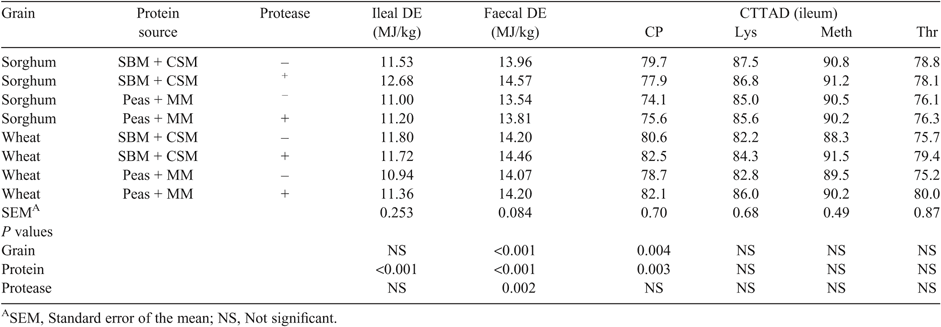Subtilisin protease increases digestible energy content but not protein digestibility in sorghum- and wheat-based diets
D. J. Cadogan A C and F. R. Dunshea BA Feedworks, Lancefield, VIC 3435.
B The University of Melbourne, Parkville, VIC 3010.
C Corresponding author. Email: david.cadogan@feedworks.com.au
Animal Production Science 55(12) 1538-1538 https://doi.org/10.1071/ANv55n12Ab049
Published: 11 November 2015
Protease increases in vitro protein digestibility (Sopade and Lu, unpublished data) of cereals and protein meals that have an apparent ileal digestibility of 90% or less. Subtilisin has also been shown to improve sorghum protein digestibility (Finn 2011) and the growth performance of pigs offered sorghum-based diets (Cadogan and Finn 2011). The hypothesis of this experiment was that the protein and energy digestibility will be enhanced by the protease in sorghum-based diets containing less digestible protein sources as opposed rations containing high quality proteins such as soybean meal (SBM).
The study was 2 × 2 × 2 factorial design with the factors being: grain (sorghum or wheat); protein source [(soybean meal (SBM) + expeller canola meal (CSM) or Peas+Meatmeal (MM)]; and protease (0 and 350 ppm Subtilisin, Dupont, Marlborough, UK). The diets were formulated to contain 14.0 MJ digestible energy (DE)/kg and 0.72 g available lysine (Lys) per MJ DE. Ileal digesta and faecal samples were collected from male pigs (PIC Australia; ~35 kg n = 14) fitted with a simple T-piece cannula 15 cm anterior to the ileo-caecal valve (van Barneveld 1999). Digesta and faecal samples were pooled and subsampled, freeze dried, and analysed for acid insoluble ash (as an indigestible marker), gross energy, crude protein (CP) and Lys, methionine (Met) and threonine (Thr), for subsequent calculation of their coefficient of total tract apparent digestibility (CTTAD). Data were analysed by ANOVA using SPSS (PASW® Statistics 18: USA).
The SBM + CSM protein source had a higher ileal (P < 0.001) and faecal (P < 0.001) DE content than the Peas + MM. There was no effect (P > 0.05) of grain type on ileal DE content, however wheat had a higher faecal DE compared to sorghum (P < 0.001). The protease had a greater effect on sorghum-based diets (P = 0.002), particularly in the presence of SBM + CSM, where ileal and faecal DE contents were increased by 1.15 and 0.61 MJ/kg, respectively (Table 1). Protease produced an improvement in faecal DE content (P = 0.002), but had no influence on ileal DE or the CTTAD of CP, Lys, Meth, or Thr. There was a significant interaction between protease and protein meal (P < 0.001) with the greater enzyme response on SBM + CSM. Sorghum exhibited an inferior CTTAD of CP (P < 0.001) to that of wheat, and Pea + MM had a lower protein digestibility (P = 0.003) compared to SBM + CSM. The hypothesis was not fully supported, as the protease had a greater positive effect in diets containing SBM + CSM, although the sorghum was more responsive to the enzyme than wheat.
References
Cadogan DJ, Finn A (2011) Journal of Animal Science 89, 690Finn A (2011) Australasian Pig Science Association Manipulating Pig Production XII, 75, ed. R.J. van Barneveld.
van Barneveld RJ (1999) Nutrition Research Reviews 12, 203–230.
| Crossref | GoogleScholarGoogle Scholar |
Supported by Pork CRC Limited Australia.



